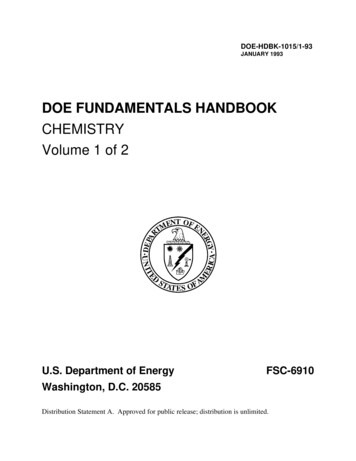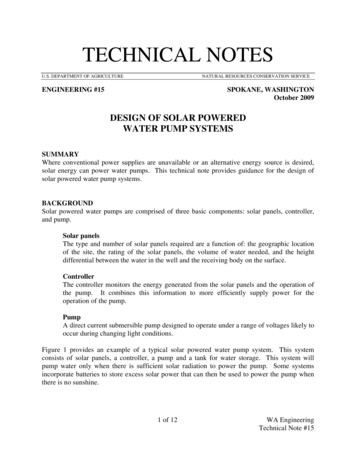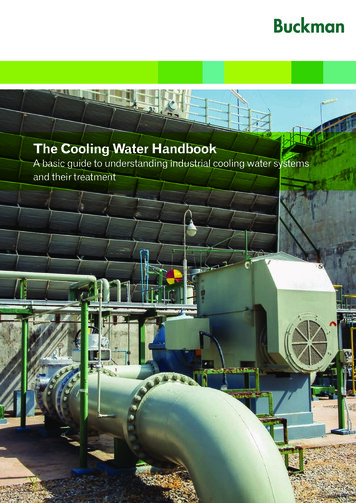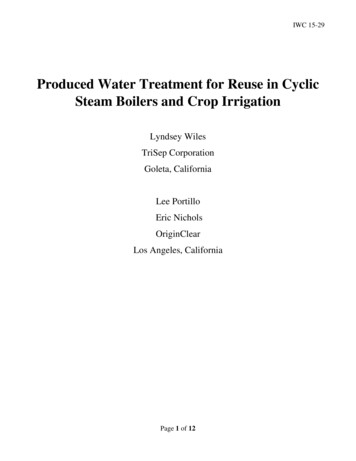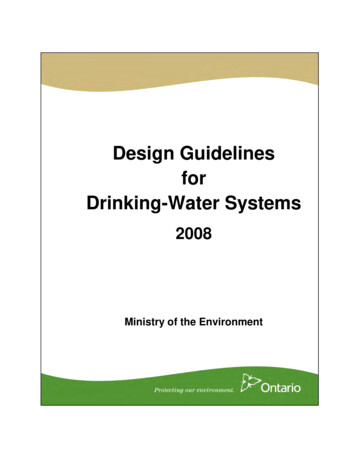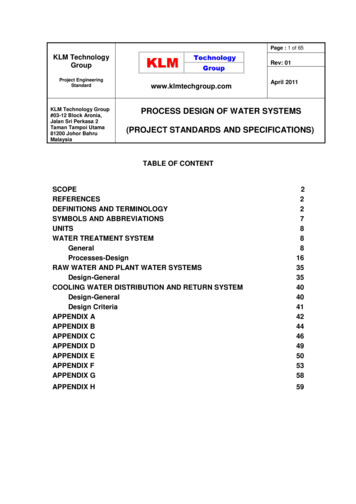
Transcription
Page : 1 of 65KLM TechnologyGroupProject EngineeringStandardKLM Technology Group#03-12 Block Aronia,Jalan Sri Perkasa 2Taman Tampoi Utama81200 Johor BahruMalaysiaRev: 01www.klmtechgroup.comApril 2011PROCESS DESIGN OF WATER SYSTEMS(PROJECT STANDARDS AND SPECIFICATIONS)TABLE OF CONTENTSCOPEREFERENCESDEFINITIONS AND TERMINOLOGYSYMBOLS AND ABBREVIATIONSUNITSWATER TREATMENT SYSTEMGeneralProcesses-DesignRAW WATER AND PLANT WATER SYSTEMSDesign-GeneralCOOLING WATER DISTRIBUTION AND RETURN SYSTEMDesign-GeneralDesign CriteriaAPPENDIX AAPPENDIX BAPPENDIX CAPPENDIX DAPPENDIX EAPPENDIX FAPPENDIX G222788816353540404142444649505358APPENDIX H59
PROCESS DESIGN OF WATERSYSTEMSKLM TechnologyGroupProject Engineering Standard(PROJECT STANDARDS ANDSPECIFICATIONS)Page 2 of 65Rev: 01April 2011SCOPEThis Project Standards and Specifications specifies the minimum requirementsfor the process design and selection of various water supply systems, used inOGP IndustriesREFERENCESThroughout this Standard the following dated and undated standards/codes arereferred to. These referenced documents shall, to the extent specified herein,form a part of this standard. For dated references, the edition cited applies. Theapplicability of changes in dated references that occur after the cited date shallbe mutually agreed upon by the Company and the Vendor. For undatedreferences, the latest edition of the referenced documents (including anysupplements and amendments) applies.1. ABMA (Amrican Boiler Manufactures' Association)2. ASME (American Society of Mechanical Engineers)3. AWWA (American Water Works Association, Inc)--Manual M21,"Water Treatment Plant Design", 1971"Ground Water", Latest Edition4. API (American Petroleum Institute)---"API Glossary of Terms Used in Petroleum Refining", 2nd.,Ed., 19625. GPSA (Gas Processors Suppliers Association)---"Engineering Data Book", Section 18, 19876. USPHS (US Public Health Service)---"Drinking Water Standards", No. 956, 1962DEFINITIONS AND TERMINOLOGYFor the preparation of the following definitions, "API Glossary of Terms Used inPetroleum Refining", and DCC, "Principles of Industrial Water Treatment", havebeen used.Alkalinity - The acid neutralizing capacity of a water. It is usually expressed as"M" alkalinity (the methyl/orange endpoint at a pH 4.3) and "P" alkalinity (the
KLM TechnologyGroupProject Engineering StandardPROCESS DESIGN OF WATERSYSTEMS(PROJECT STANDARDS ANDSPECIFICATIONS)Page 3 of 65Rev: 01April 2011phenolphthalein endpoint at a pH 8.3). Several ions contribute to alkalinity, butit is generally due to bicarbonate (HCO)-1, carbonate (CO3)-2 and hydroxyl(OH)-1 ions.Backwash - That part of the operating cycle of an ion-exchange process whereina reverse upward flow of water expands the bed, effecting such physical changesas loosening the bed to counteract compacting, stirring up and washing off lightinsoluble contaminants to clean the bed, or separating a mixed bed into itscomponents to prepare it for regeneration.Bed Expansion - The effect produced during backwashing; the resin particlesbecomes separated and rise in the column. The expansion of the bed due to theincrease in the space between resin particles may be controlled by regulatingbackwash flow.Blowdown - Blowdown is the continuous or intermittent removal of some of thewater in the boiler or cooling water system to reduce concentration of dissolvedand/or suspended solids.Boiler Water - A term construed to mean a representative sample of thecirculating boiler water, after the generated steam has been separated, andbefore the incoming feed water or added chemical becomes mixed with it, so thatits composition is affected.Break-Point Chlorination - The addition of chlorine to water to the point wherefree available residual chlorine increases in proportion to the incremental dose ofchlorine being added. At this point all of the ammonia has been oxidized.Brackish Water - Water having a dissolved matter content in the range ofapproximately 1,000 to 30,000 mg/L.Breakthrough - The first appearance in the solution flowing from an ionexchange Unit of unadsorbed ions similar to those which are depleting theactivity of the resin bed. Breakthrough is an indication that regeneration of theresin is necessary.Brine - Water having more than approximately 30,000 mg/L of dissolved matter.Chlorine Residual - The amount of available chlorine present in water at anyspecified period, subsequent to the addition of chlorine.
KLM TechnologyGroupProject Engineering StandardPROCESS DESIGN OF WATERSYSTEMS(PROJECT STANDARDS ANDSPECIFICATIONS)Page 4 of 65Rev: 01April 2011Chlorine Requirement - The amount of chlorine, expressed in mg/kg, requiredto achieve under specified conditions the objectives of chlorination.Coagulation - The precipitation from solution or suspension of fine particleswhich tend to unite in clots or curds.Drift - Water lost from a water-cooling tower as liquid droplets entrained in theexhaust air, units: kg per hour or percent of circulating water flow.Feedwater - The water supplied to a boiler to make-up for losses.Floc - Any small, tufted, or flakelike mass of matter floating in a solution, e.g., asproduced by precipitation.Fresh Water - Water having less than approximately 1,000 mg/L of dissolvedmatter.Hardness - A characteristic of water generally accepted to represent the totalconcentration of calcium and magnesium ions.Ion-Exchange - A chemical process involving the reversible interchange of ionsbetween a solution and a particular solid material (ionexchanger), such as an ionexchange resin consisting of matrix of insoluble material interspersed with fixedions of opposite charge.Langelier’s Index - A technique of predicting whether water will tend to dissolveor precipitate calcium carbonate. If the water precipitates calcium carbonate,scale formation may result. If the water dissolves calcium carbonate, it has acorrosive tendency. To calculate Langelier’s Index, the actual pH value of thewater and Langelier’s saturation pH value (pHS) are needed. Langelier’ssaturation pH value is determined by the relationship between the calciumhardness, the total alkalinity, the total solids concentration and the temperature ofthe water. Langelier’s Index is then determined from the expression pHpHS. Fig.1 is a chart used for determining Langelier’s Index. The interpretation of theresults obtained are shown below:pH - pHSTendency of WaterPositive ValueScale FormingNegative ValueCorrosiveZeroNeither Scale Forming NorCorrosive
KLM TechnologyGroupProject Engineering StandardPROCESS DESIGN OF WATERSYSTEMS(PROJECT STANDARDS ANDSPECIFICATIONS)Fig. 1 Langeller Saturation Index ChartPage 5 of 65Rev: 01April 2011
KLM TechnologyGroupPROCESS DESIGN OF WATERSYSTEMSProject Engineering Standard(PROJECT STANDARDS ANDSPECIFICATIONS)Page 6 of 65Rev: 01April 2011Also note that the presence of dissolved oxygen in the water may cause waterwith a "Zero" Langelier’s Index to be corrosive rather than "neutral".Caution must be observed in employing Langelier’s Index for controllingcorrosion or deposit formation, since there are factors that may make itsapplication inappropriate. These include temperature differences within a system,changing operating conditions, or the presence of chemical treatment in thewater.Raw Water - Untreated water.Recirculation Rate - The flow of cooling water being pumped through the entireplant cooling loop.Regenerant - The solution used to restore the activity of an ion exchanger. Acidsare employed to restore a cation exchanger to its hydrogen form; brine solutionsmay be used to convert the cation exchanger to the sodium form. The anionexchanger may be regenerated by treatment with an alkaline solution.Resin - A polymer of unsaturated hydrocarbons from petroleum processing, e.g.,in the cracking of petroleum oils, propane deasphalting, clay treatment ofthermally cracked naphthas. Chief uses include:- rubber and plastics;- impregnants;- surface coatings.Rinse - The operation which follows regeneration; a flushing out of excessregenerant solution.Ryznar Stability Index - An empirical method for predicting scaling tendenciesof water based on a study of operating results with water of various saturationindices.Stability Index 2pHS - pH(Eq. 1)Where:pHS Langelier’s Saturation pH.This index is often used in combination with the Langelier Index to improve theaccuracy in predicting the scaling or corrosion tendencies of a water. Thefollowing chart illustrates how to use this index:
KLM TechnologyGroupPROCESS DESIGN OF WATERSYSTEMSProject Engineering Standard(PROJECT STANDARDS ANDSPECIFICATIONS)RYZNAR STABILITY INDEX4.0 - 5.05.0 - 6.06.0 - 7.07.0 - 7.57.5 - 9.09.0 and higherPage 7 of 65Rev: 01April 2011TENDENCY OF WATERHeavy ScaleLight ScaleLittle Scale or CorrosionCorrosion SignificantHeavy CorrosionCorrosion IntolerableSynthetic Resin - Amorphous, organic, semisolid or solid material drived fromcertain petroleum oils among other sources; approximating natural resin in manyqualities and used for similar purposes.SYMBOLS AND INDWSEqGPSAMCLMPNOGPpHsppmmQRevSAFsp grTACTCO2TSiO2USPHSDESCRIPTIONSurface area of the settling basin, in (m²).American Boiler Manufacturers’ Association.American Petroleum Institute.American Society of Mechanical Engineers.American Water Works Association.Exchange capacity of the resins expressed in(French degrees/L per liter of consolidated resins).Deutsches Institute Fur Normung eV.Drinking Water Standards.Equation.Gas Processors Suppliers Association.Maximum Contaminant Level.Maximum Possible Numbers.Oil, Gas, and Petrochemical.Langlier Saturation pH.parts per million by mass, in (mg/kg).Inflow rate, in (m³/h).Revision.Total concentration of salts of strong acids, in[French degrees (SO4-2 Cl-1 NO3-1)].Specific Gravity (Relative Density).Complete Alkalinity Titration.Content of carbon dioxide in the water after passingthrough the cation exchanger, in (French degrees).Silica content (1 French degree 12 mg/L SiO2based on Table E.1).United States Public Health Service.
KLM TechnologyGroupProject Engineering StandardVvVaVcVLVpPROCESS DESIGN OF WATERSYSTEMS(PROJECT STANDARDS ANDSPECIFICATIONS)Page 8 of 65Rev: 01April 2011Volume of water to be supplied in (m³).Velocity of settling, in (m/h).Volume of anion resin.Volume of cation resin.Rise rate, in (m/h).Downward velocity, in (m/h).UNITSThis Standard is based on International System of Units (SI) except whereotherwise specified.WATER TREATMENT SYSTEMGeneralWater treating requirements for refinery and/or plant services depend upon:- the quality of the source of make-up water;- the manner in which the water is used;- environmental regulations; and- site climatic conditions governing wastewater disposal.These factors should be considered in selecting the overall plant process andutility systems.1. Source water typesa. Source or make up water is normally either ground or surface water,neither of which is ever chemically pure.b. Ground waters contain dissolved inorganic impurities which come from therock and sand strata through which the water passed.c. Surface waters often contain silt particles in suspension (suspendedsolids) and dissolved organic impurities (dissolved solids).d. Table 1 lists some of the common properties or characteristics and thenormal constituents of water, together with corresponding associatedoperating difficulties and potential methods of water treatment.
Page 9 of 65KLM TechnologyGroupPROCESS DESIGN OF WATER SYSTEMSProject Engineering StandardRev: 01(PROJECT STANDARDS ANDSPECIFICATIONS)April 2011Table 1 - Common Characteristics and Impurities in ee MineralAcidCarbon DioxideCHEMICAL FORMULADIFFICULTIES CAUSEDNone, usually expressedin Jackson TurbidityUnitsNoneImparts unsightly appearance to water; deposits in water lines,process equipment, boilers, etc.; interferes with most processusesDecaying organic material and metallic ions causing color maycause foaming in boilers; hinders precipitation methods such asiron removal, hot phosphate softening, can stain product inprocess useChief source of scale in heat exchange equipment, boilers,pipelines, etc.; forms curds with soap; interferes with dyeing,etc.Coagulation, settling and FiltrationFoaming and carryover of solids with steam; embrittlement ofboilers steel; bicarbonate and carbonate produce CO2 in steam,a source of corrosionLime and lime-soda softening acid treatment, hydrogenzeolite softening, demineralization, dealkalization byanion exchange, distillation, degasifyingCorrosionNeutralization with alkaliesCorrosion in water lines and particularly steam and condensatelinespH varies according to acidic or alkaline solids in water; mostnatural waters have a pH of 6.0-8.0Aeration, deaeration, neutralization with alkalies,filming and neutralizing aminespH can be increased by alkalies and decreased byacidsAdds to solids content of water, but, in itself is not usuallysignificant; combines with calcium to form calcium sulfate scaleAdds to solids content and increases corrosive character ofwaterDemineralization, distillation, reverse osmosis,electrodialysisDemineralization, distillation, reverse osmosis,electrodialysisCalcium, magnesium,banum and strontiumsalts expressed asCaCO3-1Bicarbonate (HCO3 ),-2Carbonate (CO3 ), and-1hydroxyl (OH ),expressed as CaCO3H2SO4, HCl, etc.expressed as CaCO3,titrated to methyl orangeend-pointCO2PHHydrogen ionconcentration definedas:1pH log 1(H )Sulfate(SO4)ChlorideCl-2-1MEANS OF TREATMENTCoagulation, filtration, chlorination, adsorption byactivated carbonSoftening, distillation, internal boiler water treatment,surface active agents, reverse osmosis, electrodialysis
Page 10 of 65KLM TechnologyGroupPROCESS DESIGN OF WATER SYSTEMSProject Engineering StandardCONSTITUENTCHEMICAL FORMULA-1Nitrate(NO3)FluorideFSilicaSiO2IronFe (ferrous) 3Fe (ferric)ManganeseOilMnExpressed as oil orchloroform extractablematter, ppmmO2Oxygen-1 2 2HydrogenSulfideAmmoniaH2SConductivityExpressed asmicromohos, specificconductanceNoneDissolved SolidsNH3SuspendedSolidsNoneTotal SolidsNoneRev: 01(PROJECT STANDARDS ANDSPECIFICATIONS)April 2011DIFFICULTIES CAUSEDMEANS OF TREATMENTAdds to solids content, but is not usually significant industrially;useful for control of boiler metal embrittlementNot usually significant industriallysame as ironScale, sludge and foaming in boilers; impedes heat exchange;undesirable in most processesDemineralization, distillation, reverse osmosis,electrodialysisAdsorption with magnesium hydroxide, calciumphosphate, or bone black, Alum coagulation,reverse osmosis electrodialysisHot process removal with magnesium salts adsorptionby highly basic anion exchange resins, in conjunctionwith demineralization, distillationAeration, coagulation and filtration, lime softening cationexchange, contact filtration, surface active agents forion retentionsame as ironBaffle separators, strainers coagulation and filtration,diatomaceous earth filtrationCorrosion of water lines, heat exchange equipment, boilers,return lines, etc.Cause of "rotton egg" odor; corrosionDeaeration, sodium sulfite, corrosion inhibitors,hydrazine or suitable substitutesAeration, chlonnation, highly basic anion exchangeCorrosion of copper and zinc alloys by formation of complexsoluble ionConductivity is the result of ionizable solids in solution; highconductivity can increase thecorrosive characteristics of a water"Dissolved solids" is measure of total amount of dissolvedmatter, determined by evaporation; high concentrations ofdissolved solids are objectionable because of processinterference and as a cause of foaming in boilers."Suspended Solids" is the measure of undissolved matter,determined gravimetrically; suspended solids plug lines, causedeposits in heat exchange equipment, boilers, etc."Total Solids" is the sum of dissolved and suspended solids,determined gravimetricallyCation exchange with hydrogen zeolite, chlorination,deaeration, mixed-bed demineralizationAny process which decreases dissolved solids contentwill decrease conductivity; examples aredemineralization, lime softeningVarious softening process, such as lime softening andcation exchange by hydrogen zeolite, will reducedissolved solids, demineralization; distillation; reverseosmosis electrodialysisSubsidence, filtration, usually preceded by coagulationand settlingScale in boilers and cooling water systems; insoluble turbineblade deposits due to silica vaporizationDiscolors water on precipitation; source of deposits in waterlines, boilers, etc.; interferes with dyeing, tanning paper mfr. etc.See "Dissolved Solids" and "Suspended Solids"
KLM TechnologyGroupProject Engineering StandardPROCESS DESIGN OF WATERSYSTEMS(PROJECT STANDARDS ANDSPECIFICATIONS)Page 11 of 65Rev: 01April 20112. Quality of source watersa. Type of water treatment depends on the quality of the source water andthe quality desired in the finished water.b. Adequate information on the source water is thus a prerequisite for design.This includes analysis of the water and where the supply is non-uniform,the ranges of the various characteristics. Typical water analysis calculationis given in Appendix A.c. The quality of many sources will change little over the lifetime of treatmentplant except for the seasonal changes that should be anticipated inadvance. Other sources can be expected to deteriorate substantially as aresult of an increase in wastes. A reasonably accurate prediction of suchchanges in quality is difficult to make.d. In some instances, it is best arrived at by judgment based on past trendsin quality, a survey of the source, and evaluation of future developmentsrelating to the supply.e. Ground water sources tend to be uniform in quality, to contain greateramount of dissolved substances, to be free of turbidity, and to be low incolor.f. Surface water supplies receive greater exposure to wastes, includingaccidental spills of the variety of substances.g. Generalizations like the above, although useful, are not a substitute for thedefinitive information required for plant design.h. To provide adequate protection against pollution, special studies in thedesign of intakes should have to be made to indicate the most favorablelocations for obtaining water.i. In connection with deep reservoirs, multiple intakes offer flexibility inselecting water from various depths, thus overcoming poorer water qualityresulting from seasonal changes.j. For ground water sources, the location and depths of wells should beconsidered in order to avoid pollution and secure water of favorablequality.3. Typical raw water specificationsAs a typical guidance the raw water specifications of three refineries arepresented in Tables B.1, B.2 and B.3 of Appendix B, for ground water, surfacewater and sea water.
KLM TechnologyGroupProject Engineering StandardPROCESS DESIGN OF WATERSYSTEMS(PROJECT STANDARDS ANDSPECIFICATIONS)Page 12 of 65Rev: 01April 20114. Preliminary water treatmentRegardless of the final use of source water and any subsequent treatment, itis often advisable to carry out general treatment close to the intake or well.The purpose is to protect the distribution system itself and at the same time toprovide initial or sufficient treatment for some of the main uses of water.a. In case of surface water, general protection should be provided againstclogging and deposits.i) The obstruction or clogging of apertures and pipes by foreign mattercan be avoided by screening or straining through a suitable mesh. Theprotection used is either a bar screen, in which the gap between thebars can be as narrow as 2 mm, or a drum or belt filter, with a mesh ofover 250 micrometers (μm).ii) According to the requirements of the equipment and the amount ofpollution (slime) in the water a 250 μm filter may be used on an opensystem, or microstraining down to 50 μm may be necessary in certainspecific cases. In some cases, rapid filteration through silicous sandmay be necessary after screening and will eliminate suspended matterdown to a few micrometers. Where there are large amount ofsuspended matter, grit removal and/or some degree of settling shouldbe provided.b. In case of ground water the main risks are abrasion by sand or corrosion.i) For abrasion the pumps should be suitably designed, and theprotection, which concerns only the parts of the system downstreamthe pumps, will take the form of very rapid filteration through sand,straining under pressure of use of hydrocyclones, if the grit is of theright grain size.ii) Corrosion frequently occurs on systems carrying underground waterand leads to the formation of tuberculiform concretions, which must notbe confused with scale. This corrosivity is often caused by the lack ofoxygen. The best method, therefore, of preventing corrosion is byoxygenation and filteration processes that have the dual advantage ofremoving the grit and any iron present, and of feeding into the waterthe minimum amount of oxygen needed for system to protect itself.5. Treatment process selectiona. The quality of the source, giving due consideration to variations andpossible future changes, the quality goals for the finished water, and cost,shall form the basis for selecting a treatment process.b. Often various types and combination of treatment Units would be used toachieve the performance desired (see Table 1). Determination of the most
KLM TechnologyGroupProject Engineering StandardPROCESS DESIGN OF WATERSYSTEMS(PROJECT STANDARDS ANDSPECIFICATIONS)Page 13 of 65Rev: 01April 2011suitable plan should be on a comparative cost study which includes anevaluation of the merits and liabilities of each proposal.c. The experience acquired through treatment of the same or similar sourceshall provide an excellent guide in selecting a plan.d. Where experience is lacking or where there is the desire for a differentdegree of performance, special studies should be indicated. Testsconducted in the laboratory, in existing plants, or in pilot plants should thenbe employed to obtain information for design purposes.6. Plant sizing and layoutFor plant sizing and layout the following considerations should be followed:a. Coordination of plant elements to provide for efficient production of a highquality effluent. Major considerations in treatment plant design include,frequency of basin cleaning, length of filter runs, and effluent quality.b. Economic but durable construction.c. Simplification of equipment and operations.d. Centralization of operations and control.e. Chemical feed lines as short and direct as reasonably possible.f. Simplified chemical handling and feeding.g. Essential instrumentation only.h. Appropriate use of automation.7. Potable water qualityIn refineries and/or plants water system the minimum specification requiredfor potable water should be as per local authority of municipal water supply,and is recommended to be based on establishment water systemperformance goals potable water standard specifications as required byrelevant national standards. As reference, potable water standardspecification of AWWA is included in Appendix C.8. Boiler water quality criteriaa. Boiler water chemistryThere are four types of impurities of concern in water to be used for thegeneration of steam:i) Scale-forming solids which are usually the salts of calcium andmagnesium along with boiler corrosion products. Silica, manganeseand iron, can also form scale.
KLM TechnologyGroupProject Engineering StandardPROCESS DESIGN OF WATERSYSTEMS(PROJECT STANDARDS ANDSPECIFICATIONS)Page 14 of 65Rev: 01April 2011ii) The much more soluble sodium salts which do not normally form scale,but can concentrate under scale deposits to enhance corrosion or inthe boiler water to increase carryover due to boiler water foaming.iii) Dissolved gases, such as oxygen and carbon dioxide, which can causecorrosion.iv) Silica, which can volatilize with the steam in sufficient concentrations todeposit in steam turbines.b. Boiler blowdownBlowdown should be employed to maintain boiler water dissolved solids atan appropriate level of concentration. At equilibrium the quantities ofdissolved solids removed by blowdown exactly equals those introducedwith the feedwater plus any injected chemicals.c. ABMA and ASME standardThe American Boiler Manufacturers’ Association (ABMA) and theAmerican Society of Mechanical Engineers (ASME) have developedsuggested limits for boiler water composition which depend upon the typeof boiler and the boiler operating pressure. These control limits for boilerwater solids are based on one or more of the following factors:i) Sludge and total suspended solidsThese result from the precipitation in the boiler of feedwater hardnessconstituents due to heat and to interaction of treatment chemicals, andfrom corrosion products in the feedwater. They can contribute to boilertube deposits and enhance foaming characteristics, leading toincreased carryover.ii) Total dissolved solidsThese consist of all salts naturally present in the feedwater, of solublesilica, and of any chemical treatment added. Dissolved solids do notnormally contribute to scale formation but excessively highconcentrations can cause foaming and carryover or can enhance"underdeposit" boiler tube corrosion.iii) SilicaThis may be the blowdown controlling factor in softened watercontaining high silica. High boiler water silica content can result in silicavaporization with the steam, and under certain circumstances, silicaousscale. This is illustrated by silica solubility data in Fig. 2. Silica contentof boiler water is not as critical for steam systems without steamturbines.
KLM TechnologyGroupProject Engineering StandardPROCESS DESIGN OF WATERSYSTEMS(PROJECT STANDARDS ANDSPECIFICATIONS)Page 15 of 65Rev: 01April 2011.Fig. 2 Relationship Between Boiler Pressure, Boiler Water SilicaContent and Silica Solubility in Steam
PROCESS DESIGN OF WATERSYSTEMSKLM TechnologyGroupProject Engineering Standard(PROJECT STANDARDS ANDSPECIFICATIONS)Page 16 of 65Rev: 01April 2011iv) IronOccasionally in high pressure boilers where the iron content is high inrelation to total solids, blowdown may be based upon controlling ironconcentrations, high concentrations of suspended iron in boiler watercan produce serious boiler deposit problems and are often indicationsof potentially serious corrosion in the steam/steam condensatesystems.v) While there are other considerations (such as corrosive or depositforming tendencies) in establishing limits for boiler water composition,the ABMA recommendations as per Table 2 clearly indicate that boilerfeedwater purity becomes more important as operating pressuresincreases.9. Common deposits formed in water systemsThe deposits may be classified generally as scale, sludge, corrosion products,and biological deposits. The more common types of deposits are shown inTable D.1 of Appendix D.Table 2 - Recommended Boiler Water Limits and Associated SteamPurity at Steady State Full Load Operation Drum Type Boilers*Drum Pressurebar (ga)Range TotalDissolvedSolids BoilerWatermg/kg (max)Range TotalAlkalinitymg/kg (max)SuspendedSolidsBoiler Watermg/kg (max)0.20 - 6920.76 - 31.0331.10 - 41.3841.45 - 51.7251.79 - 62.0762.14 - 68.96700 - 3500600 - 3000500 - 2500400 - 2000300 - 1500250 - 1250140 - 700120 - 600100 - 50080 - 40060 - 30050 - 25015108642Range TotalDissolvedSolids Steammg/kg(max 0.2-1.0Processes-Design1. Coagulation & flocculationa. General informationi) In water treatment, coagulation is defined as a process by whichcolloidal particles are destabilized, and is achieved mainly byneutralizing their electric charge. The product used for this neutralizingis called a coagulant.ii) Flocculation is the massing together of discharged particles as they arebrought into contact with one another by stirring. This leads the
KLM TechnologyGroupProject Engineering StandardPROCESS DESIGN OF WATERSYSTEMS(PROJECT STANDARDS ANDSPECIFICATIONS)Page 17 of 65Rev: 01April 2011formation of flakes or floc. Certain products, called flocculating agents,may promote the formation of floc.iii) Separation of the floc from the water can be achieved by filterationalone or by settling.iv) Coagulation and flocculation are frequently used in the treatment ofpotable water and preparation of process water used by industry.v) Certain dissolved substances can also be adsorbed into the floc(organic matter, various pollutants, etc.).b. Main coagulantsi) The most widely used coagulants are based on aluminum or iron salts.In certain cases, synthetic products, such as cation polyelectrolytes,can be usedii) Cation polyelectrolytes are generally used in combination with metalsalt, greatly reducing the salt dosage which would have beennecessary. Sometimes no salts at all are necessary, and this greatlyreduces the volume of sludge produced.c. pH value for coagulation and dosagei) For any water, there is an optimum pH value, where good flocculationoccurs in the shortest time with the least amount of chemical.ii) For actual application of coagulating agents, the dosage and optimumpH range should be determined by coagulation control or a jar test.d. Choice of coagulantCoagulant should be chosen after the raw water examination in laboratoryby means of flocculation test, while considering following factors:- Nature and quantity of the raw water.- Variations in the quality of the raw water (daily or seasonal especiallywith regard to temperature).- Quality requirements and use of the treated water.- Nature of the treatment after coagulation, (filter coagulation, settling).- Degree of purity of reagents, particularly in the case of potable water.2. Sedimentation-The process by which suspended or coagulated material separates fromwater by gravity is called sedimentation.Sedimentation alone, is an effective means of water treatment but is mademore effective by
for the process design and selection of various water supply systems, used in OGP Industries . before the incoming feed water or added chemical becomes mixed with it, so that . process equipment, boilers,

